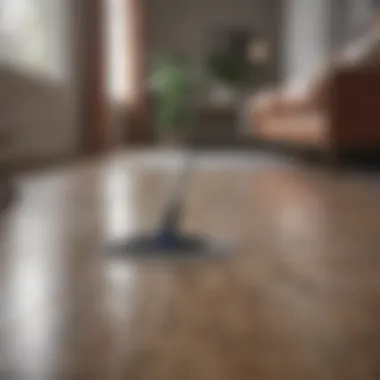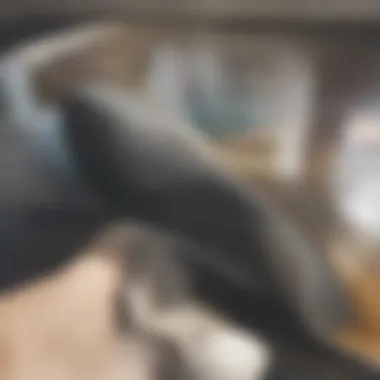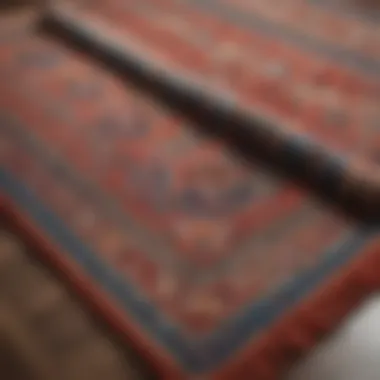How to Wash an Area Rug at Home: A Comprehensive Guide


Intro
Washing an area rug at home might seem like a straightforward task, yet it involves a nuanced approach tailored to the specific material and condition of the rug. This process can influence the longevity and appearance of your flooring investment. Whether you're dealing with a synthetic, wool, or delicate silk rug, understanding the washing techniques is essential.
Proper cleaning of your area rug not only improves its aesthetic but also enhances indoor air quality. Accumulated dust, allergens, and stains can make rugs unsightly and unhealthy. Thus, maintaining rugs is not just about cleanliness; it’s about preserving your home's overall environment.
In this guide, we will delve into tools, cleaning solutions, effective washing methods, and drying techniques. Additionally, we will highlight how to prevent common pitfalls associated with rug cleaning. Being well-informed is key to ensuring rugs remain in optimal condition for years to come.
Prolusion to Area Rugs
Area rugs serve as essential elements in both aesthetic and functional aspects of home design. Understanding the characteristics and maintenance of area rugs can enhance the longevity of your investment and contribute to a healthier living environment. Many homeowners often underestimate the importance of regular care and timely cleaning of these decorative pieces. This section addresses several key factors like the types of rugs available, their specific constraints, and the positive impacts that regular cleaning has.
Understanding Different Types of Area Rugs
Natural Fiber Rugs
Natural fiber rugs are made from materials such as jute, sisal, and cotton. These rugs are favored for their sustainable origins and natural look. One key characteristic is their breathability, which allows air to circulate, thus preventing the buildup of dust and allergy-triggering agents. However, they can be more susceptible to staining and may require more delicate cleaning methods.
Synthetic Fiber Rugs
Synthetic fiber rugs, made from materials like nylon and polyester, are known for their durability and ease of maintenance. A notable advantage is their resistance to staining and fading, making them a popular choice for high-traffic areas. These rugs are also often less expensive than natural fiber options, but they can lack in terms of environmental sustainability.
Wool Rugs
Wool rugs are recognized for their softness and warmth. The natural insulation properties of wool make it a favorite in colder climates. This type of rug is inherently stain-resistant to some extent and has a luxurious feel. However, wool rugs may require professional cleaning to maintain their integrity, as improper washing can cause them to shrink or distort.
Silk Rugs
Silk rugs offer a level of opulence that few others can match. Their luxurious appearance is complemented by their softness and vivid colors. However, silk is delicate and can be easily damaged when handled improperly. While they do require careful cleaning, their beauty often makes them worth the extra effort.
Importance of Regular Cleaning
Maintaining Appearance
The visual impact of an area rug contributes significantly to the overall feel of a room. Regular cleaning helps preserve its colors and textures, thus maintaining appearance. A well-kept rug can be a focal point of any space, while a neglected one can detract from the decor. It is vital to clean rugs periodically to keep them looking their best.
Prolonging Lifespan
Regular cleaning and maintenance are essential to prolong the lifespan of area rugs. Accumulated dirt and grime can wear down fibers over time, leading to premature deterioration. Taking steps to clean and care for rugs can save money in the long run by avoiding the need for early replacement.
Allergen Reduction
Area rugs can harbor dust, dirt, and allergens, which may impact indoor air quality. Regular cleaning reduces these health risks. A clean rug creates a healthier living space, particularly for individuals sensitive to allergens. Therefore, investing time in proper maintenance is not only beneficial for aesthetics but also for health.
Preparation for Cleaning
Preparation for cleaning area rugs is a crucial stage in the washing process. Taking time to prepare ensures that the cleaning is effective and minimizes the risk of damaging the rug. Not all rugs are the same; they are made from different materials and textures. This variability dictates the approach you need to take to clean them safely and efficiently. Understanding the preparation phase can save time and resources, ultimately yielding a better result in the cleanliness and longevity of your rug.
Assessing the Rug's Material
Identifying Natural vs. Synthetic
Identifying whether your rug is made from natural or synthetic fibers is the first step in the assessment. Natural fiber rugs, like wool and silk, require gentler cleaning compared to synthetic options made from nylon or polyester. Natural fibers can shrink or become misshapen if improperly washed.
Knowing the composition of your rug helps in selecting the appropriate cleaning method and solutions. For instance, wool rugs have natural oils that can protect them, thus many prefer mild soap for cleaning. In contrast, synthetic rugs are often more resilient and can handle stronger cleaners. The choice of fiber directly impacts the cleaning strategy, making this identification a beneficial practice in safe rug care.


Understanding Specific Cleaning Needs
Each type of material has its unique cleaning needs. For instance, silk rugs are delicate and may need dry cleaning rather than a wet wash. Conversely, synthetic rugs can be machine washed without much concern.
This understanding leads to effective cleaning strategies that prevent damage. Selecting appropriate cleaning agents also hinges on knowing the material. It is beneficial to research the specific rug material thoroughly. For example, wool may require specialized detergents that will not strip its natural oils, promoting longevity in its appearance and function.
Gathering Necessary Tools and Supplies
Vacuum Cleaner
A vacuum cleaner plays a vital role in the rug cleaning process. The primary task of vacuuming is to remove loose dirt and debris from the surface of the rug. This step is essential before any wet cleaning occurs, ensuring better results.
Using a vacuum designed for rugs, with adjustable height settings, enhances effectiveness. Additionally, avoiding beater bars on delicate fibers prevents damage. Proper vacuuming is generally advised once a week, but higher foot traffic areas may need more frequent attention. This tool is critical not only for effective cleaning but also for maintaining the rug's overall cleanliness.
Soft Bristle Brush
A soft bristle brush is another key supply when washing area rugs. Brushes help gently dislodge dirt that a vacuum may not capture, especially in high-pile rugs.
The soft bristles ensure that the fibers of the rug are not damaged during scrubbing. Utilizing this tool allows for deeper cleaning of embedded dirt while being careful not to alter the texture or appearance of the rug. Regular brushing can extend the life of the rug significantly.
Cleaning Solutions
Choosing the right cleaning solution is imperative. Different rug materials dictate the kind of cleaner that is most effective and safe to use. For example, a simple mix of water and vinegar may benefit synthetic rugs, while wool rugs might require specially formulated detergents that preserve their natural luster.
Understanding which cleaning solutions work best for which materials prevents costly mistakes, such as fading or degeneration. The key characteristic here is to assess the constituents carefully to avoid unwanted reactions during cleaning.
Towels
Having clean, absorbent towels is equally important. They are used to blot the rug after washing, ensuring excess moisture is removed before it causes mold or mildew.
Quality towels can absorb liquid without leaving lint behind, which aids in maintaining the appearance of the rug. Utilizing towels during the cleaning process is a simple yet effective way to protect against dampness and promote efficient drying.
Creating a Safety Plan
Testing for Colorfastness
Testing for colorfastness is a crucial step before proceeding with any cleaning. It involves applying a small amount of the cleaning solution on an inconspicuous area of the rug to see if colors run or fade.
If the colors remain stable, it indicates that the rug can tolerate the chosen cleaner. This ensures that the vibrant patterns on the rug stay intact. It is a simple precaution that prevents unexpected damage to the rug's visual appeal, thus being a beneficial step in the cleaning process.
Protecting Surrounding Surfaces
Protecting surrounding surfaces from water and cleaning solutions is another essential part of the safety plan. Using drop cloths or towels around the cleaning area keeps the floor safe from potential stains or moisture.
This proactive approach maintains the cleanliness of your environment while cleaning the rug. It is especially important in spaces with hardwood floors or delicate carpeting. Taking these precautions avoids any long-term damage to your home surfaces, making this step a critical component of rug cleaning.
Washing Process
The washing process is integral to maintaining the quality and aesthetic of area rugs. A thorough cleaning can not only enhance their appearance but also extend their lifespan. Proper washing techniques ensure that dirt, allergens, and stains do not become embedded in the fibers. This section outlines crucial steps, with practical recommendations tailored for various rug types to optimize their care.
Vacuuming the Rug
Technique for Effective Dirt Removal
Vacuuming is the first step in removing dirt and debris from an area rug. Utilizing a vacuum cleaner with adjustable suction is ideal for rugs made of delicate materials. A gentle approach helps to lift soil without damaging fibers. Regular and thorough vacuuming removes particles that can cause wear over time. It is a beneficial practice, especially for those who have pets or allergies. The key characteristic here is the careful balance; too much suction may damage the rug, while too little may leave dirt behind. This technique also prepares the rug for deeper cleaning.
Frequency of Vacuuming


The frequency of vacuuming depends on traffic and environment. High-traffic areas benefit from more frequent cleaning, ideally once a week. This helps to prevent dirt buildup and maintains the rug's condition. Unlike in low-traffic situations, which may only require occasional vacuuming, following a routine can make significant difference in longevity. Regular maintenance, therefore, becomes a habitual part of rug care, avoiding deeper cleaning needs down the line.
Choosing a Cleaning Solution
Commercial vs. Homemade Solutions
When selecting a cleaning solution, one can choose between commercial products and homemade solutions. Commercial solutions often provide specific formulas designed for various rug materials and stains. This can promote effective cleansing. On the other hand, homemade solutions using common household ingredients, such as vinegar or baking soda, can be safe and cost-effective. However, it's crucial to research whether these ingredients are compatible with the rug's material. Each option has its unique strengths; understanding them allows for informed decision-making in rug maintenance.
Rug-Safe Ingredients
Using rug-safe ingredients is paramount in preserving delicate fibers. Ingredients like vinegar, mild dish soap, and baking soda offer non-toxic alternatives that are effective in cleaning without risking damage. The key feature of these ingredients is their versatility and safety. They can be used on various materials without adverse reactions. This, however, requires a degree of caution. For specific stains, consulting manufacturer recommendations ensures that chemicals do not react adversely with the rug.
Manual Washing Techniques
Scrubbing Techniques
Manual washing involves scrubbing the rug by hand, which allows for more control over the cleaning process. Using a soft-bristle brush can effectively remove dirt from the fibers without causing damage. The key characteristic of this technique is precision; it enables targeted cleaning of problem areas. However, it should be done with care to avoid creating frizz or wear. This method proves to be more gentle, allowing for thorough cleaning while maintaining the integrity of the rug.
Avoiding Oversaturation
Oversaturation is a risk during manual washing that can lead to mold and mildew development. Ensuring to only use moderate amounts of water and a suitable cleaning solution is key. The unique aspect of avoiding oversaturation is maintaining the rug's structural integrity by preventing water damage. Regular checks while washing help to assess moisture levels, making timely adjustments vital to ensure proper drying afterwards.
Machine Washing Considerations
Rug Size Limitations
When considering machine washing, one must first assess the rug size. Many standard household washers may not accommodate larger area rugs. The key characteristic here is assessing the capacity of your washing machine. Overloading it can lead to ineffective cleaning and even damage to both the rug and the machine itself. Being aware of these limits can save time and frustration in the washing process.
Settings and Options
Different washing machines offer various settings which can impact rug care. Selecting delicate cycles, for example, minimizes wear and tear during cleaning. This attention to setting specifics allows for a more effective wash tailored to the rug's needs. If a rug is machine washable, checking the care label is crucial for identifying appropriate settings to maintain its quality.
Drying the Rug
Proper drying of your area rug post-washing is crucial. Incorrect drying methods can lead to irreversible damage like mold growth and color fading. This section aims to shed light on drying techniques and the importance of ensuring each rug dries adequately. Understanding this process ensures that your cleaning efforts yield lasting results. Below are the critical elements involved in the drying process and their implications for maintaining your area rugs.
Understanding the Drying Process
Air Drying Techniques
Air drying is a popular method for drying area rugs. One main reason for its popularity is that it prevents damage caused by heat. Instead of relying on artificial sources, air drying involves hanging the rug in a well-ventilated area. The natural airflow helps evaporate moisture effectively without risking the structural integrity of the fibers. A significant advantage of air drying is that it minimizes the risks of warping or shrinking. However, air drying can take more time, particularly in humid climates, which may not suit everyone. Here are key benefits of air drying:
- Gentle on fibers, reducing damage
- No risk of heat damage
- Cost-effective
Avoiding Heat Sources
Avoiding heat sources is a critical aspect of drying area rugs. Heat can severely affect the fibers of the rug, leading to fraying, fading, and even melting in synthetic versions. Not using heat sources helps maintain the rug's original colors and texture over time. A unique feature of avoiding heat is that it ensures the rug remains intact, preserving quality for an extended period. Employing this method means laying the rug flat in a shaded area or hanging it in a breeze. The downside of this approach may be longer drying times, which can be inconvenient.
Checking for Residual Dampness
Once the drying process is thought to be complete, checking for residual dampness becomes vital. This step ensures the rug is ready to be placed back into your home without risking any moisture-related issues.
Methods to Ensure Complete Drying
Several methods exist to thoroughly check if your rug is fully dry. One effective method is performing the touch test. By placing your hand on the rug, you can feel if any coolness remains, a sign of lingering dampness. Furthermore, using a moisture meter can provide accurate readings of moisture levels. Ensuring complete drying is important to avoid problems like mildew and odors. The method's reliability makes it a beneficial practice for anyone caring for rugs.
Signs of Mold and Mildew


Recognizing the signs of mold and mildew is essential for a responsible rug owner. Mold will appear as discolored spots, often with a musty smell. If you notice these signs after cleaning, it's a possible indicator that the rug was not dried properly. Early intervention is key. Leaving mold unaddressed can lead to giving off strong odors and causing health problems for residents. Furthermore, it can compromise the rug's structure. Regular checks for these signs after washing help in maintaining a clean and safe environment.
Ongoing Maintenance Tips
Ongoing maintenance tips are crucial for preserving the appearance and durability of area rugs. Regular upkeep ensures that rugs stay in good condition, preventing dirt buildup and stains. Proper cleaning techniques and schedules will help maintain aesthetics and function. Consideration of specific cleaning methods tailored to rug types is essential for long-term care.
Routine Care Practices
Regular Vacuuming Schedules
Having a regular vacuuming schedule is vital. Frequent vacuuming removes dirt and debris that can wear down fibers and dull colors. Ideally, rugs should be vacuumed at least once a week. It helps to maintain a clean environment and extends the life of the rug. Regular vacuuming is generally easy and can be done quickly, making it a popular choice. The main advantage is reduced dirt buildup and improved air quality in the home. One should keep in mind that some types of rugs may require more gentle handling, especially delicate fibers.
Spot Cleaning Techniques
Spot cleaning techniques are essential for addressing spills and stains promptly. When accidents happen, acting quickly can prevent permanent damage. This method is affordable and requires minimal resources, making it a practical option for homeowners. The unique feature of spot cleaning is its immediate action against stains. However, one should use appropriate cleaning solutions to avoid color fading or damage to fibers. Regularly checking for and treating spots as they appear contributes greatly to overall rug maintenance.
Identifying Professional Cleaning Needs
When to Seek Professional Help
Knowing when to seek professional help is a key aspect of rug care. Some issues, like deep-set stains or odors, require specialized equipment and knowledge. Relying on a professional ensures thorough cleaning without risking damage. If a rug has not been cleaned in a long time or shows signs of wear, professional cleaning might be necessary. It is beneficial because specialized cleaners have the right tools and expertise. However, the cost of professional service can be a downside for some homeowners.
Choosing a Qualified Cleaner
Choosing a qualified cleaner is critical when professional help is needed. Research local services that have good reviews and a solid reputation in the rug care industry. A good choice should demonstrate experience with various rug materials and types. Checking credentials and prior customer feedback can help ensure quality. A qualified cleaner can offer personalized attention and effective cleaning methods. The main disadvantage to keep in mind is that initial research and vetting can take time and effort, but it is worth investing in the right service.
Common Mistakes to Avoid
Understanding common mistakes is essential when washing area rugs at home. These errors can lead to damage or reduced effectiveness in cleaning. By knowing what to look out for, you can preserve your rug and maintain its quality over time. Addressing these pitfalls will ensure that cleaning is both effective and safe for the material.
Using Improper Cleaning Solutions
Harsh Chemicals
Harsh chemicals can seriously damage rugs. These substances often contain strong detergents and solvents that can strip the fibers, leading to fading or brittleness. While they might seem effective for deep cleaning, they can also cause discoloration or weak spots in the rug. It is essential to choose gentler alternatives that are safe for your rug's specific material. This choice is advisable as it promotes a longer lifespan for the rug and reduces the risk of unwanted chemical residues that may affect air quality.
Inappropriate Techniques
Inappropriate techniques in washing area rugs can result in significant issues. For example, scrubbing too hard or using the wrong brush type can fray or damage the fibers. This may lead to visible wear or even permanent damage that affects the rug’s appearance. Proper techniques emphasize a gentle approach and understanding of the rug’s material characteristics. By employing correct washing methods, such as blotting rather than scrubbing, one can avoid potential harm while still achieving cleanliness.
Neglecting Regular Maintenance
Consequences of Infrequent Cleaning
Not cleaning your rug regularly can have severe consequences. Dust and dirt accumulate and can lead to more serious problems like mold or moth infestations. Infrequent cleaning can also compromise the air quality of your home, as allergens build up in the fibers. A regular cleaning schedule is a beneficial practice, as it not only maintains your rug's appearance but also reduces long-term health risks associated with allergens and pollutants.
Long-Term Damage Risks
Long-term damage risks are a significant concern if regular maintenance is neglected. Over time, dirt can wear down the fibers and cause irreversible damage to the rug. This not only impacts its look but also reduces its value. Regular cleaning can help avoid costly replacements. Using preventive measures keeps your rug in optimal condition. Being proactive is far easier than dealing with the aftermath of neglect.
The End
In summary, the process of washing an area rug at home involves several critical steps, each carefully designed to protect the rug’s integrity while enhancing its appearance. Through this article, the significance of understanding the rug's material, selecting the right cleaning methods, and adhering to proper maintenance routines have been highlighted.
Recap of Essential Techniques
To maintain optimal condition of your area rugs, remember these essential techniques:
- Assessment of Material: Identifying whether your rug is made of natural or synthetic fibers ensures you choose suitable cleaning methods. Different fibers react differently to water and cleaning agents.
- Regular Vacuuming: Establish a routine for vacuuming the rug to remove dirt and debris. This keeps the rug fresh and reduces the risk of deep-set stains.
- Using Appropriate Cleaning Solutions: Select cleaning solutions that are safe for the material of the rug. This prevents discoloration or degradation of fibers.
- Careful Drying: Ensure that the rug dries completely to prevent mold or mildew growth. Use air drying techniques, avoiding direct heat which can damage the fibers.
- Routine Spot Cleaning: Address stains promptly with appropriate spot cleaning techniques, ensuring not to oversaturate the rug.
Final Thoughts on Area Rug Care
Caring for area rugs is an investment in both their aesthetic and functional lifespan. Regular maintenance not only preserves their vibrant look but also enhances the overall ambiance of the living space. Moreover, understanding the materials and methods suitable for your specific rug leads to more effective cleaning.







